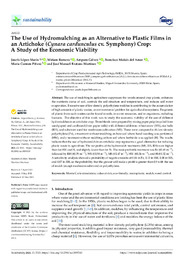Por favor, use este identificador para citar o enlazar este ítem:
https://hdl.handle.net/11000/31860Registro completo de metadatos
| Campo DC | Valor | Lengua/Idioma |
|---|---|---|
| dc.contributor.author | Lopez Marin, Josefa | - |
| dc.contributor.author | Romero Muñoz, Miriam | - |
| dc.contributor.author | Gálvez, Amparo | - |
| dc.contributor.author | del Amor, Francisco Moisés | - |
| dc.contributor.author | Piñero Zapata, María Carmen | - |
| dc.contributor.author | Brotons Martínez, José Manuel | - |
| dc.contributor.other | Departamentos de la UMH::Estudios Económicos y Financieros | es_ES |
| dc.date.accessioned | 2024-03-27T11:40:37Z | - |
| dc.date.available | 2024-03-27T11:40:37Z | - |
| dc.date.created | 2021-05 | - |
| dc.identifier.citation | Sustainability Volume 13 Issue 9 (2021) | es_ES |
| dc.identifier.issn | 2071-1050 | - |
| dc.identifier.uri | https://hdl.handle.net/11000/31860 | - |
| dc.description.abstract | The use of mulching in agriculture suppresses the weeds around crop plants, enhances the nutrients status of soil, controls the soil structure and temperature, and reduces soil water evaporation. Excessive use of low-density polyethylene mulches is contributing to the accumulation of high amounts of plastic wastes, an environmental problem for agricultural ecosystems. Fragments of plastic from such wastes can be found in soils, in water resources, and in organisms, including humans. The objective of this work was to study the economic viability of the use of different hydromulches in an artichoke crop. Three blends were prepared by mixing paper pulp (recycled from used paper) and cardboard (from paper mills) with different additives: wheat straw (WS), rice hulls (RH), and substrate used for mushroom cultivation (MS). These were compared with low-density polyethylene (Pe), a treatment without mulching on bare soil where hand weeding was performed (HW), and a treatment without mulching on bare soil where herbicide was applied (H). The results indicate that the use of hydromulch in an artichoke crop represents a good alternative for reducing plastic waste in agriculture. The net profits of the hydromulch treatments (MS, WS, RH) were higher than for HW and H, and slightly lower than for Pe. The most profitable treatment was Pe (€0.69 m−3), followed by RH (€0.59 m−3), WS (€0.58 m−3), MS (€0.47 m−3), HW (€0.36 m−3), and H (€0.32 m−3). A sensitivity analysis showed a probability of negative results of 0.04 in Pe, 0.13 in SM, 0.08 in WS, and 0.07 in RH, so the probability that the grower will make a profit is greater than 0.9 with the use of mulch (except mushroom substrate) or polyethylene. | es_ES |
| dc.format | application/pdf | es_ES |
| dc.format.extent | 17 | es_ES |
| dc.language.iso | eng | es_ES |
| dc.publisher | MDPI | es_ES |
| dc.rights | info:eu-repo/semantics/openAccess | es_ES |
| dc.rights.uri | http://creativecommons.org/licenses/by-nc-nd/4.0/ | * |
| dc.subject | Monte Carlo simulation | es_ES |
| dc.subject | value at risk | es_ES |
| dc.subject | eco-friendly | es_ES |
| dc.subject | microplastic | es_ES |
| dc.subject | mulch | es_ES |
| dc.subject | weed control | es_ES |
| dc.subject.other | CDU::5 - Ciencias puras y naturales::50 - Generalidades sobre las ciencias puras | es_ES |
| dc.title | The Use of Hydromulching as an Alternative to Plastic Films in an Artichoke (Cynara cardunculus cv. Symphony) Crop: A Study of the Economic Viability | es_ES |
| dc.type | info:eu-repo/semantics/article | es_ES |
| dc.relation.publisherversion | https://doi.org/ 10.3390/su13095313 | es_ES |

Ver/Abrir:
10 2021 sustainability-13-05313-v2.pdf
1,66 MB
Adobe PDF
Compartir:
 La licencia se describe como: Atribución-NonComercial-NoDerivada 4.0 Internacional.
La licencia se describe como: Atribución-NonComercial-NoDerivada 4.0 Internacional.
.png)